
World of Horror Review
World of Horror is easily one of the most engaging RPG experiences I’ve played this year. As I put more hours into it, the more addicted I became. After three years in early access, this retro-styled horror RPG has finally launched with its full release. Before delving right into this review of World of Horror, I believe it’s important to understand exactly what kind of game it is.
It is not a standard adventure that has people undergoing quests with a party for many hours. Rather, it’s a roguelite RPG featuring turn-based battles.

Once players start a run, they’re given five randomized cases on a bulletin board that they can solve in any order. After completing them, a final ascent up a lighthouse concludes the run. Investigating a case lasts roughly 10-15 minutes each, and completing an entire run takes maybe an hour at most. If you’re familiar with the Call of Cthulhu tabletop board game, think of World of Horror as a single-player bite-sized version of it.
While progress isn’t carried over in between playthroughs, a run can potentially unlock a new character, new events, new endings, and most importantly, new knowledge for players to take with them in the future as they learn more about World of Horror’s numerous mechanics.
Frankly, I didn’t do much outside research on the game as I dove in, so I admittedly had no clue what kind of game it was until I booted it up for the first time. It’s a remarkable title that’s largely made by a single Polish developer, Paweł Koźmiński.
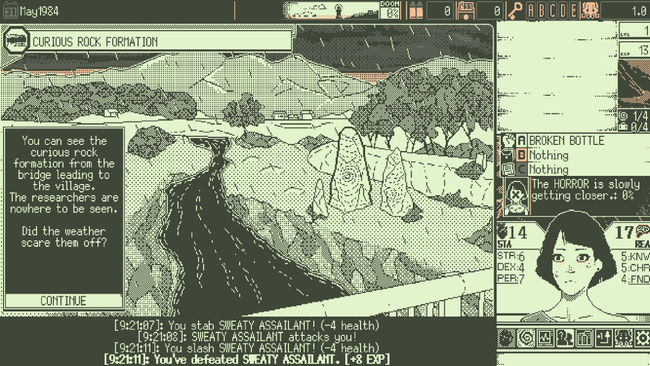
World of Horror takes a bit of time to understand how its systems all work. The basic premise is that occult and supernatural activities are on the rise in Shiokawa, Japan as an eldritch god is on the verge of waking up to end modern civilization. Players are tasked with stopping the ritual that’s awakening the eldritch god from its slumber before it’s too late.
There are three important resources to maintain in order to prevent a game over - stamina, reason, and doom. Think of stamina and reason as two HP bars that should never reach 0, while doom is a percentage that should never reach 100; failing to properly manage any of these three aspects will result in an instant game over.
Everything is menu-driven. Once players begin an investigation, they usually have free rein to explore different parts of the town. Although the location to advance the case forward is clearly marked with a circle, driving the case forward immediately isn’t always the best thing to do. Perhaps buying a weapon, armor, or some handy items first is preferable, but keep in mind that visiting places often advances the doom counter. There are also several cases that take place in a specific isolated location that don’t allow free town exploration at all.
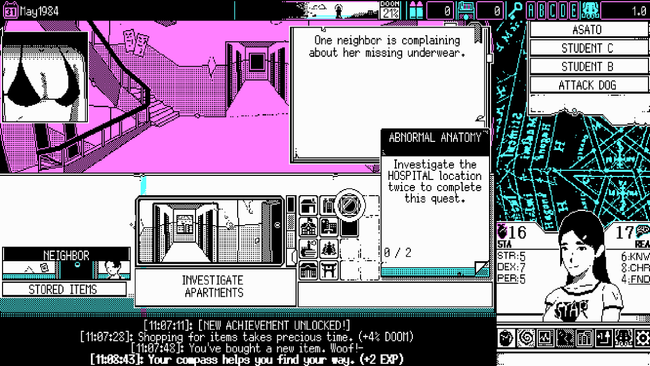
Investigating a location will trigger random events. These can take the form of interactions that execute a skillcheck or initiate a battle. Characters all have a strength, dexterity, perception, knowledge, charisma, and luck stat; the exclusive perks available to each of them as they level up help define where their strengths lie.
Kirie specializes in spellcasting due to her high knowledge stat and exclusive perks that grant her increased spell slots along with learning a new spell after a case is solved. Meanwhile, Haru is a heavy hitter with melee weapons though needs a constant supply of cigarettes to truly shine, since the nicotine rush status it provides grants him a damage bonus. Mizuki, on the other hand, is the character to play if you want to rely on others to do the fighting because her high charisma and perks make her allies more powerful the more she has.
Although players can manually choose which stat to raise per level up, it’s unlikely to fundamentally alter the core strengths of a character because of how short a playthrough is. A character won’t even hit level 10 in most cases, so developing a basic understanding of how to best utilize a character is key to consistently winning runs. I loved figuring out how to beat the game as different characters; it often pushed me to consider new strategies that I hadn’t considered previously. Hell, one of the best tactics to use with a certain character was just throwing stuff from their inventory at the enemy.
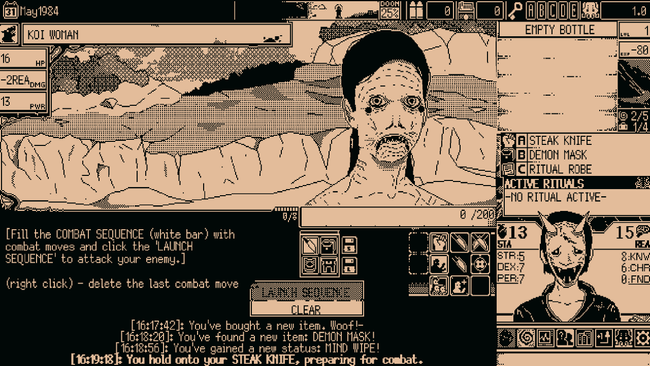
There is a certain cleverness in World of Horror’s combat system. It may look complicated at first glance, but it’s quite simple, flexible, and effective. The most important part to pay attention to is the action bar; every command in battle consumes a certain amount of time to perform the action. A person can stack any combination of battle commands as long as it doesn’t exceed the 200-point limit on the action bar. Once players launch their character’s sequence of combat actions, the enemy will then take their turn and retaliate.
A large amount of useful info is displayed all at once in the battle user interface. Along with enemy health, battles also inform people in advance how much damage a character will incur if they get hit. Some foes only decrease stamina or reason, while others may hit both; there are even some that only increase doom.
Plus, World of Horror surfaces which stat affects a weapon’s performance, so finding a weapon that synergizes with a character’s stat specialty will enable that weapon to hit harder with higher accuracy. If the chances to land an attack are on the lower end, players may have to spend additional actions to either increase the likelihood or guarantee that their next attack will hit.
An additional layer of combat to consider is that some enemies are incorporeal, such as ghosts. They can’t be hit through normal methods, and people will have to rely on several unconventional ways to deal with them. One of them is a funny last-ditch effort in finding the correct sequence of claps and bows to successfully perform a ritual that will instantly banish them.
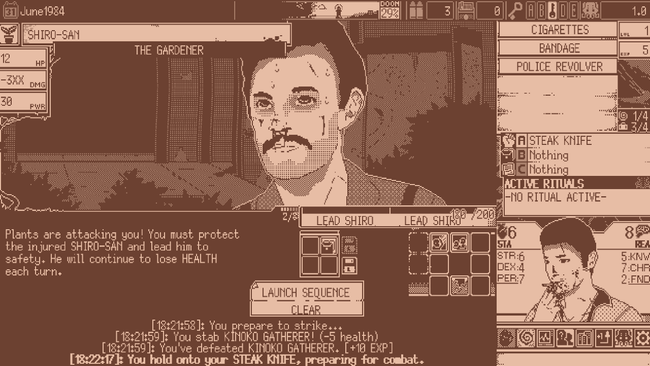
All relevant commands in battle are neatly organized between different tabs for offensive, defensive, supportive, and spiritual actions. This modular approach to the user interface is employed throughout all of World of Horror. Although it can initially seem wonky, it ended up being an extremely efficient way of conveying a lot of info to players with minimal wasted space.
One glance at World of Horror and it’s undeniable how eye-catching this game is. Its art direction is clearly influenced by the terrors crafted by legendary manga artist Junji Ito. There is a certain level of confidence in how body horror is expressed in World of Horror; expect a healthy dose of deformed skin and rotting flesh amidst other monstrosities lying in wait.
All of the game’s artwork was produced in MS Paint, impressively enough. The level of detail on display is astonishing. While the “default” color palette in World of Horror is black-and-white, there’s a vast amount of color filters and palettes to change up its visual style; there’s even a toggle between displaying it in 1-bit or 2-bit if you want to add more color depth. It wonderfully recreates the aesthetic of old Macintosh games.
The sound design and soundtrack in World of Horror is also one of its best aspects. ArcOfDream and Qwesta provided their talents in composing the eerie atmosphere through chiptunes. There's a sense of dread with a slight hint of desperation in each of the different battle themes. Out-of-combat tunes provide varying senses of wonder in a hesitant, yet fearful manner. Even the uncommon interactions with the environment in specific scenarios are unnerving. I consider the overall sound direction of World of Horror to be immaculate; it perfectly nails the exact mood it’s going for at any given moment.
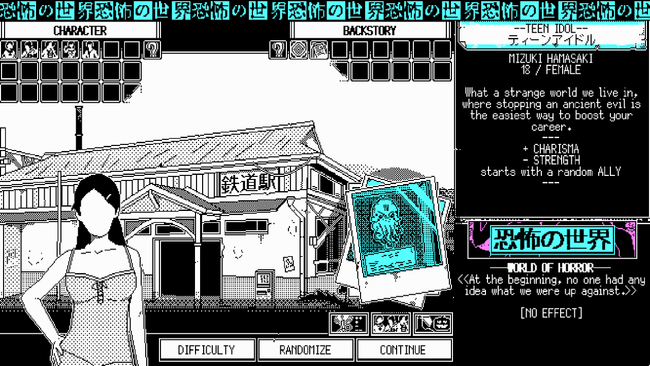
My one minor gripe with the game boils down to the inherently repetitive nature of recurring cases that I’ve already fully solved. Every investigation has multiple endings, though some events in them may affect subsequent cases. Eventually, players will reach a point where they have exhausted almost everything the game has to offer and playthroughs will inevitably dilute down to rerolling cases on the bulletin board before beginning their run to either include a case that is missing an ending or an entirely new investigation that was recently unlocked.
Regardless of this small issue, World of Horror is still an amazing game from top to bottom. Some of the cases can get a bit goofy, which provides a nice offset to some of the more terrifying ones. There aren’t any loud jumpscares to frighten players. Instead, it mostly leans on atmospheric horror and delightfully disgusting designs. The most intense it gets is replacing the mouse cursor with a knife icon and having to stab a… rather tender part of an individual to potentially save them.
World of Horror is simply awesome. The wait for its full release may have been lengthy, but I think the final product was well worth it. There aren’t really that many games that nail the feeling that World of Horror provides. It delicately balances a lot of systems to provide a challenging, yet fair roguelite RPG experience. I highly recommend World of Horror for anyone who wants an enjoyable, unique RPG that is okay with pacing it out through multiple bite-sized playthroughs.